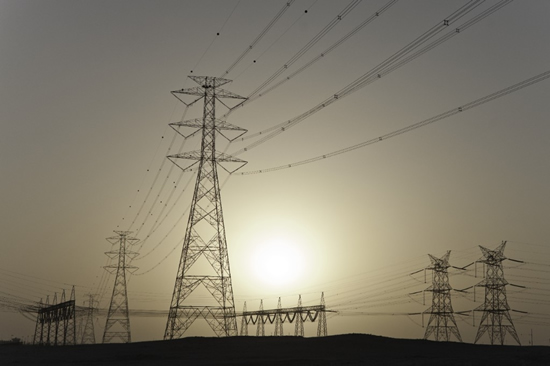Key Technologies Driving Germany's Energy Transition
With government funding of EUR 400 million, the Kopernikus Initiative is the biggest research venture ever to deal with Germany's energy transition. Siemens is involved in three out of the Initiative's four research projects.
For centuries, people thought the Earth was the center of the universe. Not until the 16th century did mathematician Nicholas Copernicus suggest the opposite – founding how we think of the world today. Now, Germany’s Federal Ministry of Education and Research has named the biggest research project in its energy transition after him: the Kopernikus Initiative. And Siemens is an active member of three out of the Initiative’s four research projects.
In 2015, according to Germany’s Federal Ministry of the Economy and Energy, renewable energy sources accounted for about 30 percent of gross electric power generation. But apart from expanding wind and solar power, many questions about the transition to the new energy mix are still unanswered. How can we keep the power grid stable when feed-ins are volatile? How can we get electricity to where it’s needed? How can surplus electricity be stored? The Kopernikus Initiative is intended to find answers to these questions and more, and to move the German energy transition ahead.
A Ten-Year, Multi-Million-Euro Project
The Federal Ministry of Education and Research will invest a full EUR 400 million in the Kopernikus Initiative to develop technological and economic solutions for restructuring the energy system. “We will show that it’s possible to have a reliable, affordable, clean energy supply without sacrificing our standard of living or jobs,” says Federal Research Minister Johanna Wanka. “By 2025, we’ll have new energy concepts under way that can be applied on an industrial scale.”
Four Topics for the Energy Transition
The Kopernikus Initiative is the biggest, most complex research venture on the energy transition. It comprises four research projects, three of which include Siemens as a participant. “Being involved in three out of four projects is a major success for Siemens. It underscores how much government trusts our work toward implementing the energy transition,” explains Armin Schnettler, Head of the corporate Energy and Electronics research unit at Siemens Corporate Technology.
Along with Siemens, some 1,000 institutions filed applications with 41 different project proposals. Out of that long list, 230 applicants were accepted. The key criteria for acceptance were the proposal’s relevance to the energy system and the applicants’ concept and capabilities. The research ministry identified four general topics for how to speed up the energy transition. Besides developing power grids and storage solutions, the focus is also on new industrial processes and an optimized interplay among all sectors.
New Grid Structures and Storage Technologies
Topic area 1 is called “New Grid Structures.” Here the ENSURE consortium will study how power grids need to be adapted to handle irregular electricity feed-ins, and which technologies can be applied cost-effectively. The chief focus is on how the cost of expanding the grid can be reduced through an intelligent combination of power generated both centrally and from distributed sources. Current estimates from the grid development plan put the cost at as much as EUR 34 billion by 2025. Siemens is contributing its expertise on systems management, and also on questions of grid stability, grid control and grid protection.
In topic area 2, teams of experts are addressing storage options for green power, under the title “Power-to-X.” Here the goal is to store more than 90 percent of future electricity from renewable sources – when it’s not needed in the grid – in the form of chemical elements, gas energy sources, and fuels. The investigators are working on the industrial prerequisites for that capability. Siemens is contributing its expertise in electrolysis to form synthetic gas.
Industrial Processes and Systems Integration
In the third topic area, industrial processes, the “SynErgie” project won the contract. It’s intended to demonstrate for the first time in Germany, across a wide range of sectors, how energy-intensive production processes in particular can be adapted to a fluctuating energy supply. This has been estimated to reduce the cost of supplying energy to industry by more than EUR 10 billion by 2020 – while cutting CO2 emissions substantially at the same time. Siemens is contributing its skills in evaluating automation methods.
The only project where Siemens is not involved is concerned with systems integration, and is looking at the energy transition as a process of change that will involve society as a whole.
Flexible Project Organization
The four consortiums have already started work. The project schedule is divided into three phases, to allow for adjustments to current developments and research results. All teams will be assisted by independent experts who will evaluate the analyses’ progress.
All four projects share the goal of identifying technologies for implementing the energy transition, and developing them for large-scale applications. The Kopernikus Initiative could thus make a crucial contribution toward advancing our ability to deal with the energy transition challenge, and help make Germany a role model for other countries. After all, achieving worldwide carbon dioxide reductions will take multiple individual energy transitions in a variety of countries.
Contact:
Sebastian Webel
Editorial Office
Siemens AG
sebastian.webel@siemens.com
Original Internet Article:
https://www.siemens.com/innovation/en/home/pictures-of-the-future/energy-and-efficiency/efficient-energy-use-energy-transition-an-export-hit.html
Pictures of the Future
https://www.siemens.com/innovation/en/home/pictures-of-the-future.html
Die semantisch ähnlichsten Pressemitteilungen im idw



